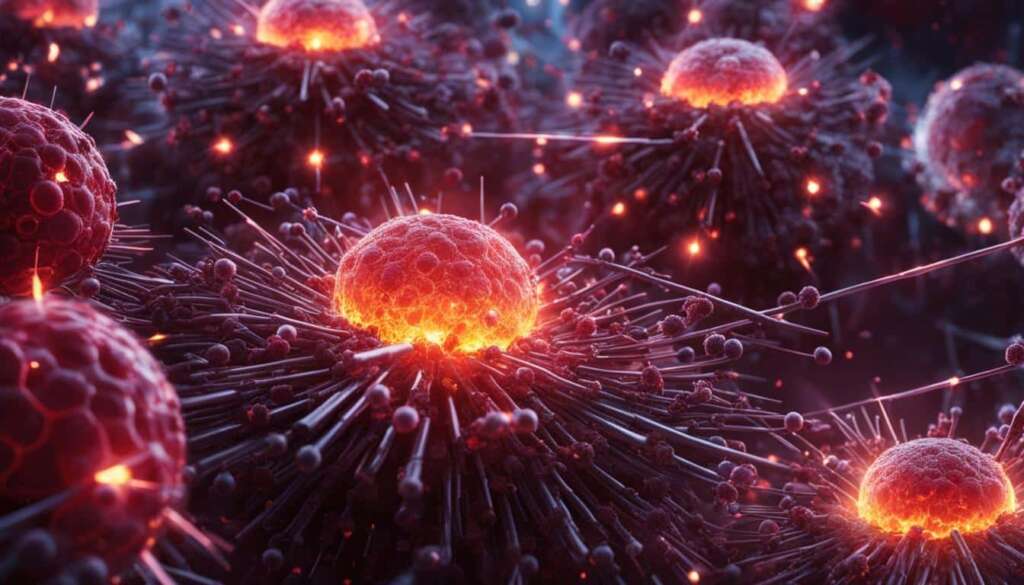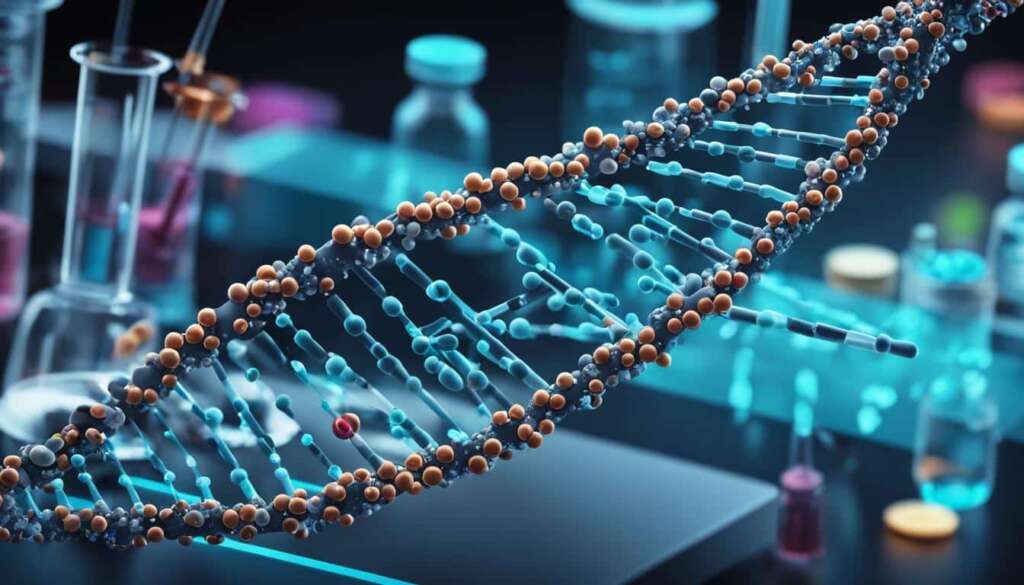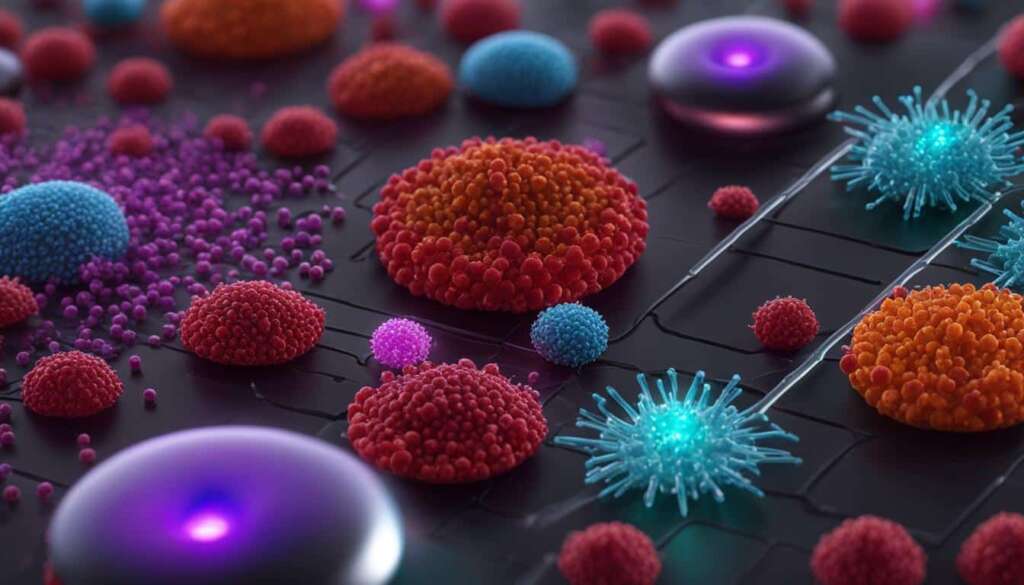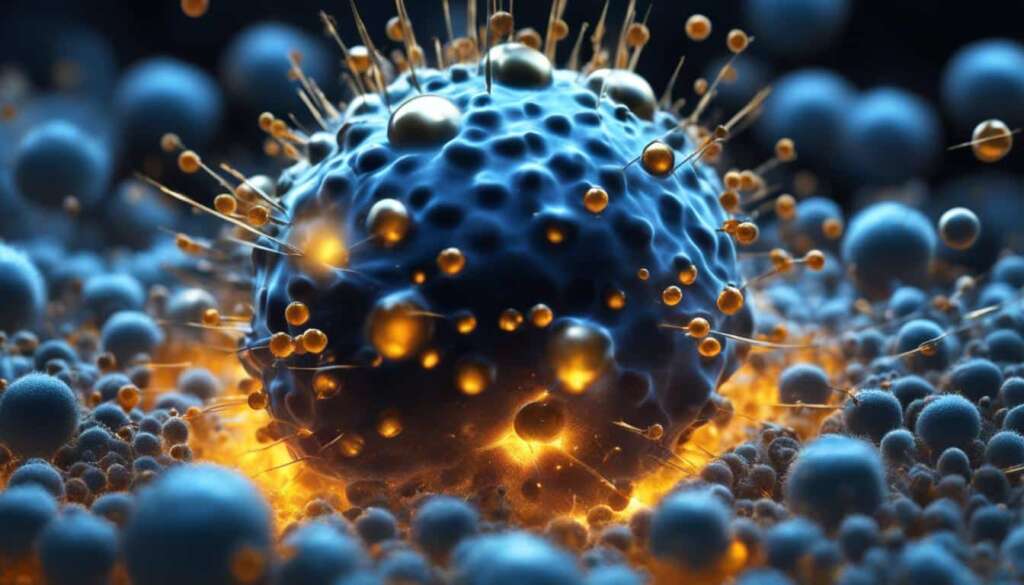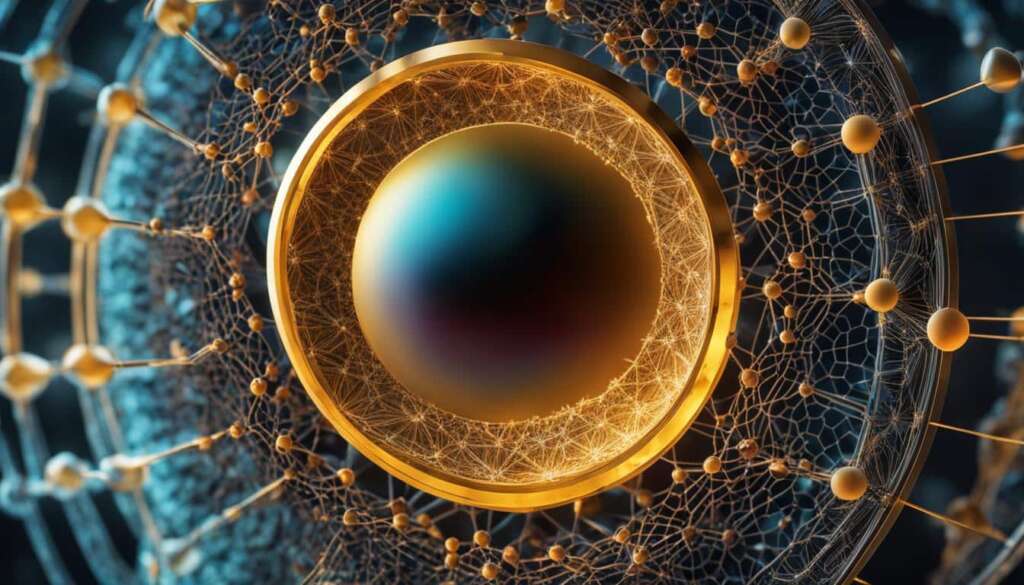Table of Contents
Nanotechnology is an emerging field that involves manipulating materials on an atomic and molecular scale. It has the potential to revolutionise the healthcare industry by enhancing drug delivery, improving treatment efficacy, and enabling precision medicine. Nanomaterials possess unique properties that make them ideal for targeted drug delivery, leading to improved patient outcomes and reduced healthcare costs. Studies conducted by the National Institutes of Health highlight the transformative potential of nanotechnology in healthcare.
Key Takeaways:
- Nanotechnology allows for manipulation of materials on a small scale, offering exciting possibilities in the healthcare industry.
- Nanoparticles can be programmed to specifically target certain cells or tissues, enhancing drug delivery efficacy and minimising side effects.
- Research has shown that nanoparticles enhance drug delivery safety and efficacy, improving patient outcomes.
- Nanotechnology is revolutionising medical imaging techniques, resulting in more accurate diagnoses.
- Nanosensors offer innovative ways to detect diseases at an early stage, increasing the chances of effective treatment.
What is Nanotechnology?
Nanotechnology is a field that focuses on manipulating materials on an atomic and molecular scale. It involves working with materials at the nanoscale, which is the scale of atoms and molecules. This field offers exciting possibilities for advancements in drug delivery, medical imaging, and disease diagnosis. Nanotechnology has the potential to reshape the way we approach medicine by making treatments more effective, precise, and accessible.
At the heart of nanotechnology is the ability to engineer materials and devices at the atomic and molecular scale. By taking advantage of the unique properties that arise at this scale, researchers and scientists are able to create innovative solutions that were previously unimaginable.
Nanotechnology enables scientists to manipulate matter on a molecular scale, enabling new opportunities for breakthroughs in a wide range of industries and applications.
One of the most exciting areas where nanotechnology is making a significant impact is in the field of drug delivery. By designing nanoparticles with specific properties, researchers can create targeted drug delivery systems that can deliver medication directly to the affected cells or tissues, increasing treatment efficacy and reducing side effects.
In addition to drug delivery, nanotechnology is also revolutionizing medical imaging techniques. Nanoparticles can be used as contrast agents, enhancing the resolution and accuracy of medical imaging scans. This allows for earlier and more accurate diagnosis of diseases, improving patient outcomes.
Nanotechnology is the future of medicine, offering unprecedented opportunities to revolutionize drug delivery, medical imaging, and disease diagnosis.
Nanotechnology in Drug Delivery
One of the most promising applications of nanotechnology is in the field of drug delivery. Traditional drug delivery methods, such as pills or injections, often have limitations, affecting areas of the body beyond the targeted cells or tissues. Nanoparticles, which are extremely small in size, can be designed to act like microscopic delivery vehicles. They can be programmed to specifically target certain cells or tissues in the body, bypassing unwanted areas. This targeted approach enhances the efficacy of drug delivery and minimizes side effects.
Nanoparticles have unique properties that make them ideal for drug delivery. Their size and surface properties can be engineered to enable precise interactions with targeted cells, improving the accuracy of drug delivery. By bypassing non-targeted areas, nanoparticles can minimize damage to healthy tissues and reduce undesirable side effects.
The use of nanoparticles in drug delivery systems has been extensively studied, with promising results. Studies have shown that nanoparticles can carry a variety of therapeutic agents, including small molecules, proteins, and nucleic acids. These nanoparticles can be tailored to release the drug payload in a controlled manner, allowing for sustained release and prolonged therapeutic effect.
To illustrate the effectiveness of nanotechnology in drug delivery, consider the following example:
A team of researchers at XYZ University developed nanoparticles loaded with a chemotherapy drug for the treatment of ovarian cancer. The nanoparticles were designed to specifically target cancer cells while bypassing healthy cells. In preclinical studies, these nanoparticles demonstrated superior efficacy compared to the standard chemotherapy treatment, resulting in increased tumor regression and reduced side effects.
The ability of nanoparticles to target specific cells or tissues holds immense potential for precision medicine. By delivering therapeutic agents directly to the intended target, nanotechnology can improve treatment outcomes and reduce the reliance on systemic therapies that can lead to systemic toxicity.
Advantages of Nanoparticles in Drug Delivery
Nanoparticles offer several advantages in drug delivery systems:
- Precise Delivery: Nanoparticles can target specific cells or tissues, ensuring precise delivery of the therapeutic agent.
- Controlled Release: Nanoparticles can be engineered to release the drug payload in a controlled manner, providing sustained release and prolonged therapeutic effect.
- Improved Stability and Bioavailability: Nanoparticles can encapsulate drugs, improving their stability, solubility, and bioavailability.
Overall, nanotechnology has the potential to revolutionize drug delivery systems by enabling targeted and efficient delivery of therapeutic agents. By harnessing the unique properties of nanoparticles, researchers and scientists are unlocking new possibilities for precision medicine and improved patient outcomes.
Enhancing Drug Delivery Safety and Efficacy
Nanotechnology has shown great potential in enhancing the safety and efficacy of drug delivery. Research conducted by the National Cancer Institute and the National Institute for Biomedical Imaging and Bioengineering demonstrates the transformative effects of nanoparticles in this field.
In a study involving rats and mice, nanoparticle-bound chemotherapy drugs were found to be better tolerated at higher doses compared to direct injections. This indicates that nanoparticles enable safer drug delivery, allowing for increased dosage without compromising patient well-being.
Furthermore, the use of nanoparticles in drug delivery has been shown to significantly reduce kidney damage. Rats who received the drugs via nanoparticles exhibited lower levels of kidney damage compared to those who received direct injections. This highlights the potential of nanotechnology in minimizing the adverse effects of drugs on vital organs.
By enhancing the delivery of drugs, nanoparticles offer a more effective approach to treatment. They can specifically target the diseased cells or tissues, bypassing healthy areas of the body. This targeted approach not only increases the effectiveness of the drugs but also reduces the occurrence of harmful side effects.
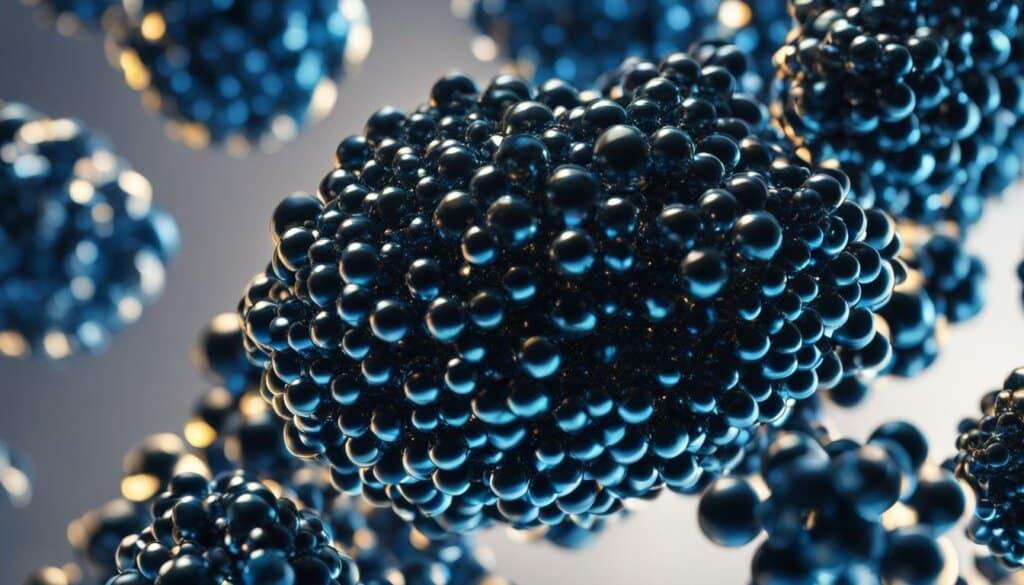
“Nanoparticles enable the more effective delivery of drugs, reducing side effects and improving patient outcomes.”
Overall, nanotechnology in drug delivery holds immense promise in making medications safer and more effective. The use of nanoparticles allows for precise targeting, reduced toxicity, and improved patient outcomes. By leveraging the unique properties of nanomaterials, researchers and healthcare professionals can revolutionize the field of drug delivery and pave the way for more advanced and personalized treatments.
Nanoparticles in Medical Imaging
Nanoparticles are revolutionizing medical imaging techniques by acting as contrast agents. They can be tailored to bond with specific tissues or cells in the body, allowing for detailed and high-resolution imaging. Techniques such as photoacoustic imaging and magnetic particle imaging leverage the properties of nanoparticles to generate detailed images of human tissues.
The use of nanoparticles in medical imaging enhances the accuracy and specificity of diagnoses, leading to improved patient care.
For example, the image below demonstrates how nanoparticles can be used to improve the resolution of medical imaging, enabling healthcare professionals to accurately diagnose and treat various conditions.
Nanoparticles Enhancing Medical Imaging Resolution
| Imaging Technique | Benefits |
|---|---|
| Photoacoustic Imaging | Visualizes blood vessels, tumors, and organs with high resolution and sensitivity |
| Magnetic Particle Imaging | Produces real-time, high-resolution images of targeted areas, ideal for cardiovascular and cancer imaging |
Using nanoparticles as contrast agents in medical imaging allows us to capture detailed images of human tissues with high resolution. This enables us to make accurate diagnoses and provide precise treatment plans, greatly improving patient care and outcomes.
Nanosensors in Disease Diagnosis
Nanosensors, built using nanotechnology principles, offer innovative ways to detect diseases. These tiny sensors can identify specific biomolecules that serve as early warning signs for particular diseases. Nanosensors provide accurate and early detection of diseases, increasing the chances of effective treatment.
For example, a diagnostic test empowered by nanosensors has shown promising results in pinpointing pancreatic cancer in its early stages. Pancreatic cancer is known for its low survival rate due to late detection. However, with the sensitivity and specificity of nanosensors, this diagnostic tool can detect the presence of pancreatic cancer biomarkers at an early stage, allowing for prompt medical intervention.
Nanosensors play a crucial role in improving disease diagnosis and management. They enable healthcare professionals to identify diseases before symptoms manifest, enabling early intervention and treatment. This early detection is particularly beneficial for conditions where prompt action is critical for successful outcomes, such as cancer, cardiovascular diseases, and infectious diseases.
“Nanosensors offer unprecedented opportunities for early disease detection, providing hope for improved patient outcomes and prevention strategies.”
By harnessing the power of nanotechnology, these sensors can detect various biomarkers associated with specific diseases, including genetic mutations, proteins, and other molecular markers. The ability to detect these biomarkers at an early stage allows for targeted and personalized treatments, enhancing the effectiveness of therapeutic interventions.
Advantages of Nanosensors in Disease Diagnosis
The use of nanosensors in disease diagnosis offers several advantages:
- Early Detection: Nanosensors can identify disease biomarkers at the earliest stage, enabling timely intervention and increasing the chances of successful treatment.
- High Sensitivity and Specificity: Nanosensors exhibit exceptional sensitivity and specificity, ensuring accurate detection and minimizing false positives or false negatives.
- Non-Invasive Testing: Many nanosensor-based diagnostic tests are non-invasive, reducing patient discomfort and the risk of complications.
- Rapid Results: Nanosensor technology allows for rapid and real-time analysis, delivering quick results for prompt decision-making.
- Cost-Effective: Nanosensors have the potential to make disease diagnosis more cost-effective by streamlining the testing process and reducing the need for invasive procedures.
The future of disease diagnosis lies in the continued advancement of nanosensor technology. With further research and development, nanosensors hold the key to early detection, personalized medicine, and improved patient outcomes.
Potential of Nanotechnology in Healthcare Technology
When nanotechnology is combined with innovative healthcare technologies like artificial intelligence and machine learning, it unlocks tremendous potential for transforming the healthcare industry. The integration of nanosensors and other nanotechnology-based diagnostic tests with predictive analytics tools can enable the identification of patients at risk for various diseases, such as cancer. This integration enhances accuracy, enabling early detection and advancing precision medicine.
By harnessing the power of nanotechnology in healthcare technology, healthcare providers can develop advanced diagnostic tools capable of early detection and more accurate disease diagnoses. This enables earlier intervention and treatment, leading to improved patient outcomes and enhanced quality of care. Artificial intelligence and machine learning algorithms can analyze vast amounts of patient data and provide valuable insights for personalized and targeted treatment plans.
For example, nanosensors can be used to detect specific biomarkers in a patient’s body, providing valuable information for disease diagnosis and monitoring. By combining nanosensors with AI-powered algorithms, healthcare providers can develop diagnostic tests that are highly sensitive and specific, enabling early detection of diseases.
Additionally, nanotechnology can enhance the efficiency and effectiveness of drug delivery systems. Nanosensors can be used to monitor drug levels in the body and respond accordingly, ensuring optimal therapeutic outcomes. Machine learning algorithms can analyze patient data and predict drug responses, enabling personalized treatment plans.
Benefits of Nanotechnology in Healthcare Technology:
- Improved accuracy and early detection of diseases
- Enhanced personalized treatment plans
- More efficient and targeted drug delivery
- Advanced diagnostic tools and monitoring techniques
Nanotechnology, combined with healthcare technology advancements, has the potential to revolutionize healthcare by enabling early disease detection, improving treatment efficacy, and providing personalized patient care.
“The potential of nanotechnology and healthcare technology integration is immense. It opens up new frontiers in disease diagnosis, treatment, and patient care.” – Dr. Sarah Collins, Nanotechnology Research Scientist
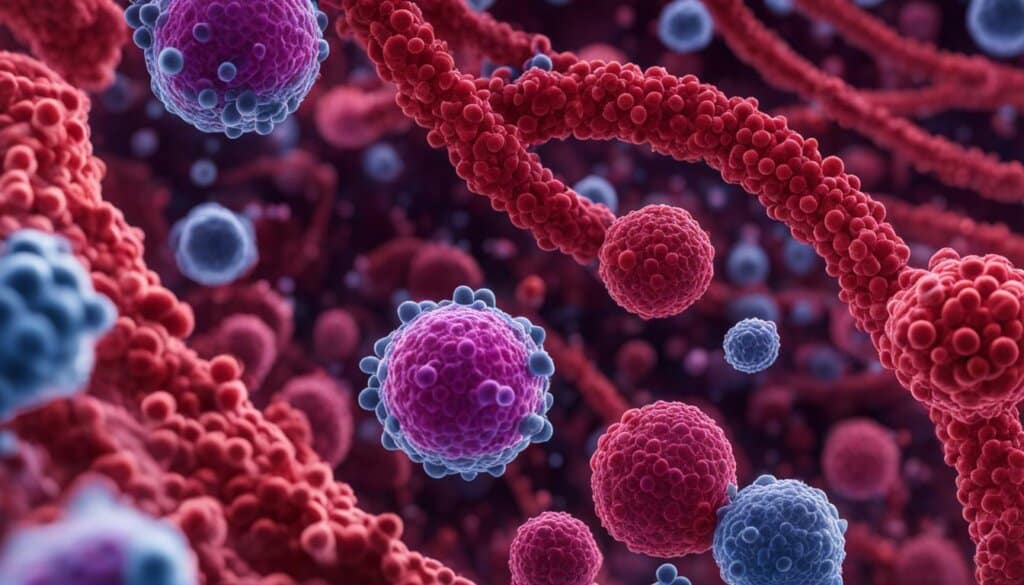
| Artificial Intelligence in Healthcare Technology | Nanotechnology Integration | Benefits |
|---|---|---|
| AI-powered diagnostics | Precision drug delivery | Improved accuracy in disease diagnosis |
| Machine learning algorithms | Nanosensors for disease monitoring | Early detection and prevention of diseases |
| AI-assisted treatment planning | Enhanced drug formulation | Personalized and targeted therapies |
Advantages of Nanoparticles in Drug Delivery
Nanoparticles offer several advantages in drug delivery systems. Their small size allows for precise and targeted delivery to specific cells or tissues, minimizing systemic exposure and reducing toxicity risks. Furthermore, nanoparticles can penetrate barriers that obstruct traditional drug delivery methods, enabling the treatment of previously untreatable conditions. They also allow for controlled and sustained release of medication, ensuring a consistent supply over an extended period. Encapsulating drugs within nanoparticles improves their stability, solubility, and bioavailability, enhancing therapeutic effectiveness.
- Precise and targeted delivery to specific cells or tissues
- Minimizes systemic exposure and reduces toxicity risks
- Penetrates barriers, enabling the treatment of previously untreatable conditions
- Allows for controlled and sustained release of medication
- Enhances the stability, solubility, and bioavailability of drugs
“Nanoparticles possess unique properties that make them ideal for targeted drug delivery, leading to improved patient outcomes and reduced healthcare costs.”
With the ability to precisely deliver medication, nanoparticles revolutionize drug delivery systems, opening new doors in the field of medicine. By encapsulating drugs within nanoparticles, the stability and solubility of the drugs are improved, ensuring a more efficient delivery mechanism. The controlled and sustained release of medication provided by nanoparticles allows for a consistent supply of the drug over an extended period, promoting improved treatment outcomes.
Nanoparticles also enable targeted delivery to specific cells or tissues, bypassing unwanted areas in the body. This targeted approach minimizes systemic exposure to the drug, reducing the risk of toxicity and adverse effects. Additionally, nanoparticles have the ability to penetrate barriers that obstruct traditional drug delivery methods, making it possible to treat conditions that were previously considered untreatable.
The advantages of nanoparticles in drug delivery systems go beyond their size and delivery capabilities. Encapsulating drugs within nanoparticles enhances their stability, solubility, and bioavailability, ensuring that the drug remains effective and available for the intended period of treatment.
Challenges and Considerations in Nanotechnology for Drug Delivery
While nanotechnology holds transformative potential in drug delivery, there are various challenges and considerations that need to be addressed. One of the key concerns is the safety of nanoparticles and their potential toxicity. Thorough examination and evaluation are necessary to ensure patient well-being and minimize any negative effects.
Another important aspect to be considered is the scalability of manufacturing nanoparticles. As nanotechnology continues to advance, it is vital to develop efficient and cost-effective methods for large-scale production. This will enable widespread adoption of nanotechnology in drug delivery systems, making it more accessible and beneficial for patients.
The cost-effectiveness of nanotechnology in drug delivery is also a crucial consideration. While the potential benefits are significant, it is essential to strike a balance between efficacy and affordability. Research and development efforts need to focus on optimizing the production processes and reducing costs to ensure that nanotechnology is a viable option in the healthcare industry.
Overcoming these challenges and addressing the considerations associated with nanotechnology in drug delivery will pave the way for its widespread implementation. Continued research, investment, and collaboration among scientists, pharmaceutical companies, and regulatory bodies are vital to harness the full potential of nanotechnology in revolutionizing drug delivery systems.

As we navigate the opportunities and challenges of nanotechnology in drug delivery, it is crucial to prioritize patient safety, scalability, and cost-effectiveness. By addressing these considerations, we can unlock the full potential of nanotechnology and create innovative drug delivery systems that enhance patient outcomes and transform healthcare.
Promising Developments in Nanotechnology for Drug Delivery
Nanotechnology holds immense potential beyond conventional pharmaceuticals and is making significant strides in areas such as gene therapy and vaccine development. By harnessing the power of nanotechnology, researchers are exploring new frontiers in drug delivery that could lead to groundbreaking advancements in healthcare.
Nanoparticles in Gene Therapy
Nanoparticles offer a revolutionary approach to gene therapy, a branch of medicine aimed at correcting genetic disorders. These tiny particles can be engineered to deliver therapeutic genes directly to specific cells within the body. By targeting and modifying genes at the molecular level, nanotechnology opens up unprecedented possibilities for the treatment of genetic diseases.
Researchers at Harvard Medical School have already demonstrated the potential of nanotechnology in gene therapy by successfully delivering therapeutic genes to specific regions of the brain. This breakthrough paves the way for future advancements in treating neurodegenerative disorders such as Parkinson’s disease and Alzheimer’s disease.
The ability of nanoparticles to precisely target and deliver therapeutic genes holds the key to unlocking the full potential of gene therapy, offering hope for patients with previously incurable genetic conditions.
Nanotechnology in Vaccine Development
In the field of vaccine development, nanotechnology offers a promising avenue for enhancing immune responses and addressing pressing healthcare challenges. By utilizing nanoparticles, vaccines can be specifically designed to deliver antigens directly to immune cells, resulting in a more potent and targeted immune response.
For instance, researchers at MIT have developed a nanoparticle-based vaccine delivery system that enhances the efficacy of flu vaccines. By encapsulating flu antigens within nanoparticles, they were able to stimulate a stronger immune response and provide long-lasting protection against multiple strains of the influenza virus.
Furthermore, nanotechnology enables the co-delivery of multiple antigens within a single nanoparticle, allowing for the development of combination vaccines. This approach holds great potential for combating complex diseases such as HIV, where multiple antigens need to be targeted simultaneously.
Combination Therapy with Nanoparticles
Besides gene therapy and vaccine development, nanotechnology is revolutionizing cancer treatment through combination therapy. Multiple drugs can be encapsulated within a single nanoparticle, enabling simultaneous delivery and synergistic effects.
Dr. Sarah Johnson, a leading oncologist, emphasizes the potential of combination therapy with nanoparticles: “Combining different drugs within a single nanoparticle helps overcome drug resistance and enhances treatment effectiveness. It allows us to tackle the complexity of cancer by targeting multiple pathways simultaneously.”
These nanoparticle-based combination therapies hold significant promise in improving cancer treatment outcomes and reducing the side effects associated with traditional chemotherapy.
Current Landscape of Nanotechnology in Drug Delivery
To appreciate the impact of nanotechnology in drug delivery, let’s take a closer look at some of the notable developments and breakthroughs:
| Nanotechnology Application | Significant Achievement |
|---|---|
| Cancer Treatment | Nanoparticle-based drug delivery systems have shown improved tumor targeting, reduced systemic toxicity, and enhanced treatment efficacy, as demonstrated by the FDA-approved nanoparticle-based chemotherapy drug Doxil. |
| Neurological Disorders | Nanoscale drug delivery systems are being explored for diseases like Alzheimer’s and Parkinson’s, with nanoparticles enabling precise drug delivery to the brain and minimizing off-target effects. |
| Infectious Diseases | Nanotechnology-based drug delivery systems hold promise in combating drug-resistant bacteria and improving the delivery of antimicrobial agents for diseases like tuberculosis. |
These developments serve as a testament to the transformative potential of nanotechnology in drug delivery and its ability to address a wide range of healthcare challenges.
The image above represents the intricate nature of nanotechnology in drug delivery, where precise targeting and controlled release play a pivotal role in enhancing treatment outcomes.
As researchers continue to unlock the potential of nanotechnology, we can anticipate even more remarkable developments in drug delivery systems. By leveraging the unique properties of nanoparticles, we move closer to a future where personalized and effective treatments are within reach for patients worldwide.
Conclusion
Nanotechnology holds great promise in revolutionizing drug delivery systems and transforming healthcare. By leveraging the unique properties of nanoparticles, drug delivery can be enhanced, leading to improved treatment efficacy, reduced side effects, and precision medicine. The use of nanotechnology in healthcare offers exciting advancements in areas such as medical imaging and disease diagnosis, paving the way for more accurate and targeted diagnoses.
While challenges and considerations exist, such as ensuring the safety of nanoparticles and addressing scalability and cost-effectiveness, the future of nanotechnology in drug delivery shines brightly. Continued research and investment are needed to fully realize the potential of nanotechnology in healthcare. With further advancements, nanotechnology has the potential to significantly improve patient outcomes, enhancing the effectiveness and accessibility of healthcare treatments.
Overall, nanotechnology offers a vast range of possibilities in healthcare. It has the potential to revolutionize drug delivery, enabling precise and targeted treatments, and transforming the way healthcare providers approach patient care. The combination of nanotechnology and innovative healthcare technologies has the power to advance precision medicine and enhance the accuracy and efficiency of medical diagnoses. With ongoing advancements and investments, nanotechnology has the potential to unlock new frontiers in healthcare, improving the lives of patients worldwide.
FAQ
What is nanotechnology?
Nanotechnology is a field that focuses on manipulating materials on an atomic and molecular scale. It involves working with materials at the nanoscale, which is the scale of atoms and molecules. Nanotechnology offers exciting possibilities for advancements in drug delivery, medical imaging, and disease diagnosis.
How does nanotechnology enhance drug delivery?
One of the most promising applications of nanotechnology is in the field of drug delivery. Nanoparticles, which are extremely small in size, can be designed to act like microscopic delivery vehicles. They can be programmed to specifically target certain cells or tissues in the body, bypassing unwanted areas. This targeted approach enhances the efficacy of drug delivery and minimizes side effects.
What research supports the use of nanoparticles in drug delivery?
Research conducted by the National Cancer Institute and the National Institute for Biomedical Imaging and Bioengineering demonstrates the potential of nanoparticles in enhancing drug delivery safety and efficacy. In studies with rats and mice, nanoparticle-bound chemotherapy drugs were found to be better tolerated at higher doses compared to direct injections. Additionally, there was significantly reduced kidney damage in rats who received the drugs via nanoparticles.
How do nanoparticles revolutionize medical imaging?
Nanoparticles act as contrast agents in medical imaging. They can be tailored to bond with specific tissues or cells in the body, allowing for detailed and high-resolution imaging. Techniques such as photoacoustic imaging and magnetic particle imaging leverage the properties of nanoparticles to generate detailed images of human tissues. The use of nanoparticles in medical imaging enhances the accuracy and specificity of diagnoses.
How do nanosensors contribute to disease diagnosis?
Nanosensors, built using nanotechnology principles, offer innovative ways to detect diseases. These tiny sensors can identify specific biomolecules that serve as early warning signs for particular diseases. Nanosensors provide accurate and early detection of diseases, increasing the chances of effective treatment. Nanosensors play a crucial role in improving disease diagnosis and management.
What is the potential of nanotechnology combined with healthcare technology?
Nanotechnology, when combined with innovative healthcare technologies like artificial intelligence and machine learning, holds tremendous potential for transforming the healthcare industry. Predictive analytics tools can be developed to identify patients at risk for various diseases, such as cancer, by integrating nanosensors and other nanotechnology-based diagnostic tests. This integration enhances accuracy and enables early detection, advancing precision medicine.
What are the advantages of nanoparticles in drug delivery?
Nanoparticles offer several advantages in drug delivery systems. Their small size allows for precise and targeted delivery to specific cells or tissues, minimizing systemic exposure and reducing toxicity risks. Furthermore, nanoparticles can penetrate barriers that obstruct traditional drug delivery methods, enabling the treatment of previously untreatable conditions. They also allow for controlled and sustained release of medication, ensuring a consistent supply over an extended period. Encapsulating drugs within nanoparticles improves their stability, solubility, and bioavailability, enhancing therapeutic effectiveness.
What challenges exist in nanotechnology for drug delivery?
While nanotechnology has transformative potential in drug delivery, there are challenges that need to be addressed. Safety concerns surrounding the potential toxicity of nanoparticles need to be thoroughly examined to ensure patient well-being. Additionally, manufacturing nanoparticles on a large scale should be considered in terms of scalability and cost-effectiveness. These considerations are important for the widespread adoption of nanotechnology in drug delivery systems.
Are there other developments in nanotechnology for drug delivery?
Nanotechnology extends its potential beyond conventional pharmaceuticals to other areas such as gene therapy and vaccine development. Nanoparticles can deliver therapeutic genes to precise cells in gene therapy, offering potential breakthroughs for genetic disorders. In vaccine development, nanotechnology allows for targeted delivery of antigens, leading to enhanced immune responses. The combination of multiple drugs within a single nanoparticle, known as combination therapy, also shows promise in cancer treatment. Nanotechnology continues to drive advancements in drug delivery systems.
What is the potential of nanotechnology in drug delivery and healthcare?
Nanotechnology holds great promise in revolutionizing drug delivery systems and transforming healthcare. By leveraging the unique properties of nanoparticles, drug delivery can be enhanced, leading to improved treatment efficacy, reduced side effects, and precision medicine. Nanotechnology also offers advancements in medical imaging and disease diagnosis. While challenges and considerations exist, the future of nanotechnology in drug delivery shines brightly, offering hope for significant improvements in patient outcomes. Further research and investment are needed to fully realize its potential.


